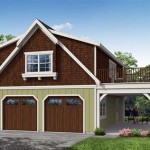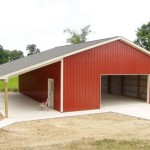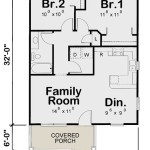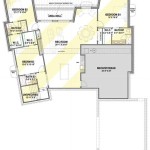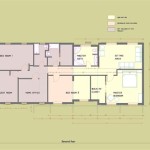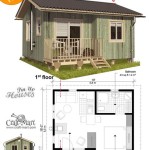Exploring the Versatility of 4-5 Bedroom House Plans
The decision to build a home is a significant undertaking, deeply intertwined with lifestyle aspirations and future needs. Among the myriad choices to be made, the selection of a house plan stands as a pivotal step. For growing families, those anticipating the future addition of members, or individuals who simply value ample space, 4-5 bedroom house plans present a compelling option. These plans offer a balance of functionality, privacy, and potential for customization, catering to a diverse range of needs and preferences. This article delves into the nuances of 4-5 bedroom house plans, highlighting key considerations and exploring the benefits they offer.
Understanding the Spatial Needs and Lifestyle Requirements
Before embarking on the process of selecting a 4-5 bedroom house plan, a thorough assessment of spatial requirements and lifestyle patterns is essential. This involves a careful evaluation of several factors, including the number of occupants, their respective needs for privacy, and the intended use of each room. For example, a family with multiple children may require dedicated bedrooms for each child to foster independence and focus. Conversely, a family with older children or frequent overnight guests might benefit from having a guest room that can be easily converted into a home office or hobby space when not needed as a bedroom.
Beyond the purely functional aspects, lifestyle considerations play a critical role in determining the optimal house plan. Individuals who frequently entertain guests may prioritize open-concept living areas that facilitate social interaction and flow. Those who value tranquility and solitude may prefer a layout that emphasizes separation between living and sleeping areas. Remote workers often require a dedicated office space equipped with adequate lighting, ventilation, and soundproofing to ensure productivity and minimize distractions. Understanding these nuances is crucial to selecting a house plan that aligns with individual preferences and enhances the overall quality of life.
Furthermore, anticipated future needs should be taken into account. Families planning to expand may want to consider a house plan that offers the potential for future additions or modifications, such as unfinished basement space or a flexible room that can be converted into a bedroom as needed. Similarly, individuals anticipating the eventual need for aging-in-place features may want to explore house plans that incorporate accessibility considerations, such as wider doorways, ramp access, and grab bars in bathrooms. Careful planning and foresight can ensure that the selected house plan continues to meet evolving needs for years to come.
Analyzing Different Layout Options and Floor Plan Configurations
4-5 bedroom house plans come in a wide array of layout options and floor plan configurations, each offering its own unique advantages and disadvantages. Common configurations include single-story ranch-style homes, two-story colonial-style homes, and split-level designs. Each of these architectural styles offers a different distribution of space and functionality, catering to varying preferences and lifestyle requirements.
One-story ranch-style homes are characterized by their horizontal layout, with all living spaces located on a single level. This configuration offers several advantages, including ease of access for individuals with mobility limitations and a seamless flow between indoor and outdoor spaces. Ranch-style homes often feature open-concept living areas and generously sized bedrooms, making them well-suited for families with young children or individuals who value convenience and accessibility.
Two-story colonial-style homes, on the other hand, offer a vertical layout, with bedrooms typically located on the upper level and living spaces situated on the main floor. This separation of living and sleeping areas provides enhanced privacy and noise reduction, making them ideal for families with teenagers or individuals who value tranquility and solitude. Colonial-style homes often feature formal living and dining rooms, as well as a centrally located staircase that serves as a focal point of the design.
Split-level designs represent a hybrid approach, incorporating elements of both ranch-style and two-story homes. These configurations typically feature multiple levels that are staggered vertically, with short flights of stairs connecting each level. Split-level homes offer a unique distribution of space and functionality, often incorporating a lower level suitable for a recreation room or home office, as well as an upper level dedicated to bedrooms and bathrooms. This design can be particularly well-suited for sloping lots or properties with unique topographical features.
Beyond the overall architectural style, the arrangement of rooms within the floor plan is another critical consideration. Open-concept living areas facilitate social interaction and flow, while compartmentalized layouts offer greater privacy and separation. Master suites, often featuring private bathrooms and walk-in closets, provide a luxurious retreat for homeowners. The placement of bedrooms relative to living areas can also impact noise levels and privacy, particularly for individuals who work from home or have young children.
Evaluating Key Features and Design Elements
In addition to the overall layout and floor plan configuration, several key features and design elements can significantly impact the functionality and aesthetic appeal of a 4-5 bedroom house plan. These include the size and layout of the kitchen, the number and placement of bathrooms, the presence of a garage or carport, and the availability of outdoor living spaces such as patios, decks, and porches.
The kitchen serves as the heart of the home, and its design should reflect the homeowner's cooking style and lifestyle. A well-designed kitchen typically features ample counter space, storage cabinets, and modern appliances, as well as a functional layout that facilitates efficient food preparation and cleanup. Open-concept kitchens that flow seamlessly into living and dining areas are popular choices for those who enjoy entertaining, while more traditional compartmentalized kitchens offer greater privacy and separation.
The number and placement of bathrooms are also critical considerations. A house with multiple occupants should ideally have at least two full bathrooms to accommodate their respective needs. Master suites often feature private bathrooms with luxurious amenities such as soaking tubs, walk-in showers, and dual vanities. Powder rooms, typically located near the main living areas, provide convenient access for guests. The strategic placement of bathrooms throughout the house can enhance convenience and privacy for all occupants.
The presence of a garage or carport provides secure parking for vehicles and additional storage space. Attached garages offer convenience and protection from the elements, while detached garages can provide greater design flexibility. Carports, which are typically less expensive than garages, offer basic protection from the elements without the added cost of enclosed walls. The size of the garage or carport should be adequate to accommodate the number of vehicles owned by the homeowners, as well as any additional storage needs.
Outdoor living spaces such as patios, decks, and porches extend the living area of the home and provide opportunities for recreation and relaxation. Patios, typically constructed of concrete or pavers, offer a low-maintenance surface for outdoor dining and entertaining. Decks, typically constructed of wood or composite materials, provide an elevated platform with expansive views. Porches, either covered or uncovered, offer a welcoming entrance to the home and a comfortable space to relax and enjoy the outdoors. The design and size of these outdoor spaces should be tailored to the homeowners' lifestyle and preferences.
Moreover, aspects such as natural light, HVAC systems, and the materials used play a big role. Large windows can dramatically improve the atmosphere inside the home, but also impact energy efficiency. Efficient HVAC systems will reduce cost and be mindful about environmental concerns. Material selection affects the home's look, durability and maintenance needs.
Ultimately, selecting a 4-5 bedroom house plan requires careful consideration of a wide range of factors, from spatial requirements and lifestyle patterns to layout options, floor plan configurations, and key design elements. By thoroughly evaluating these considerations, prospective homeowners can make informed decisions that result in a home that meets their needs, enhances their quality of life, and provides a comfortable and functional living space for years to come.

Room To Grow 5 Bedroom House Plans Houseplans Blog Com

5 Bedroom 4 Bath Rectangle Floor Plan Google Search Modular Home Plans Ranch House Basement

5 Bedroom 4 Bath House Plans

5 Bedroom 4 Bath House Plans

Room To Grow 5 Bedroom House Plans Houseplans Blog Com

Traditional Floor Plan Main 1054 15 Farmhouse Plans Family House

Symmetrical Florida Style House Plan With 5 Bedrooms 660009jmd Architectural Designs Plans
Prairie Style House Plan 5 Beds 4 Baths 4545 Sq Ft 935 13 Houseplans Com

Exclusive 5 Bedroom Home Plan With Formal Dining And Keeping Rooms 510207wdy Architectural Designs House Plans

Luxury 2 Story Modern 5 Bedroom House Plan 1817

